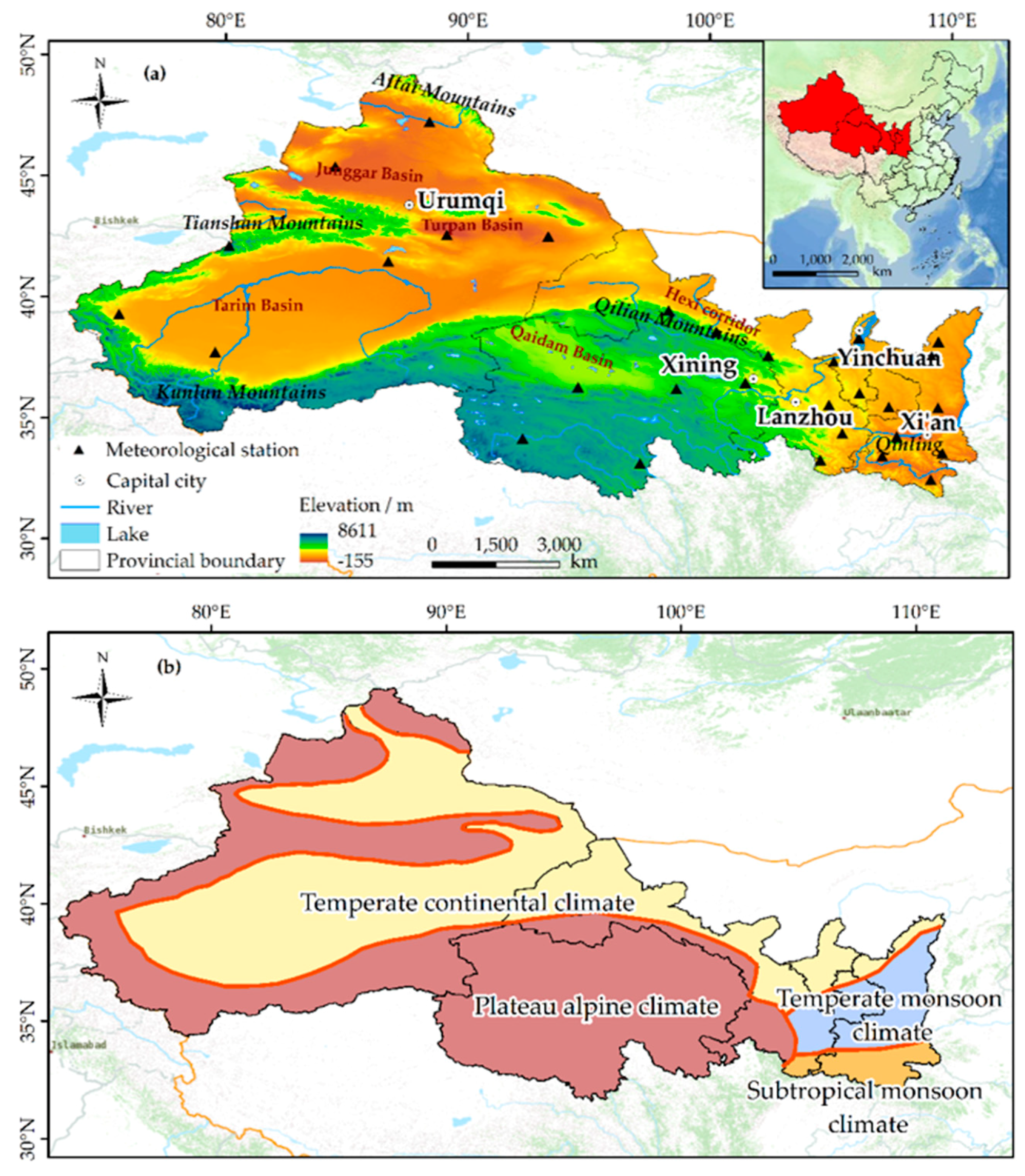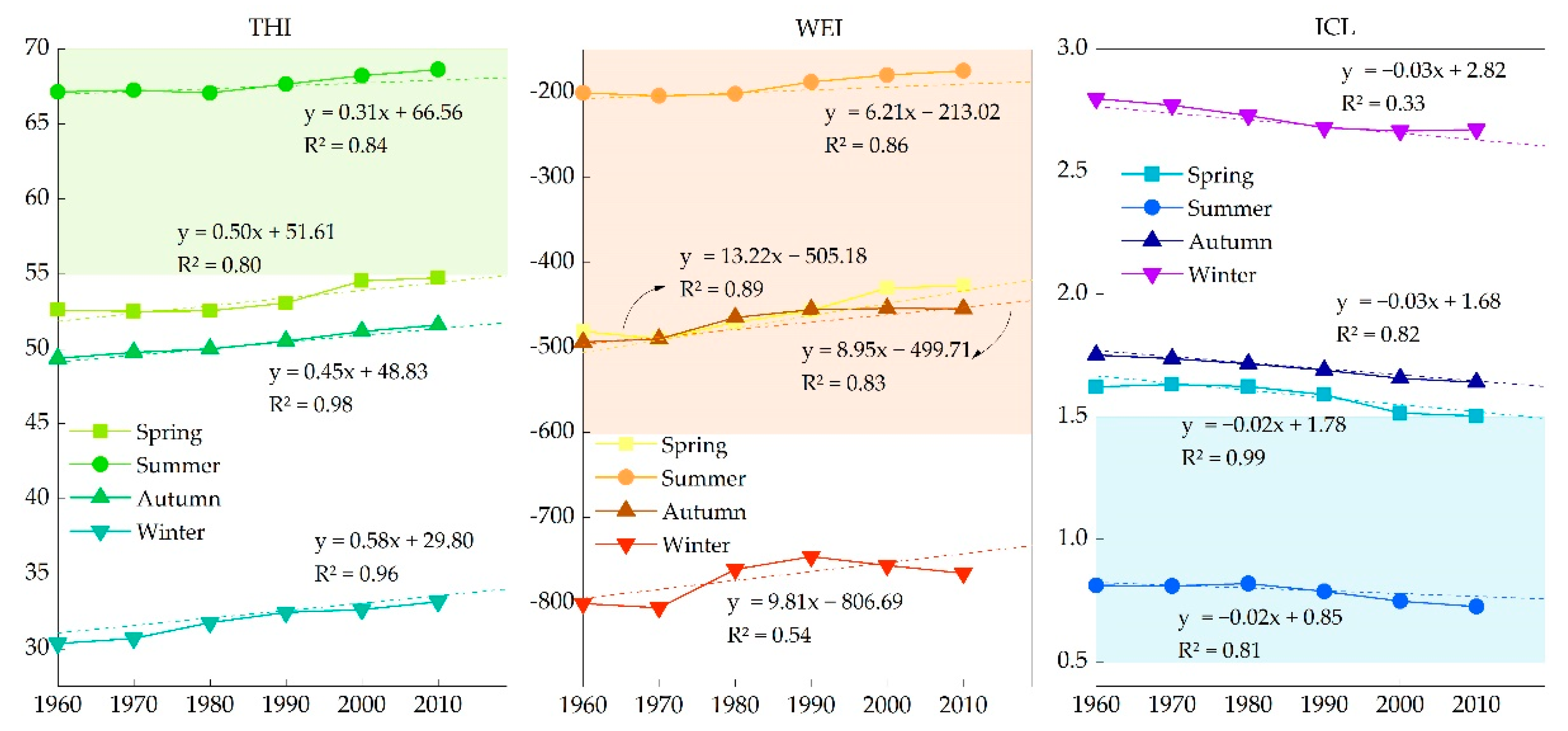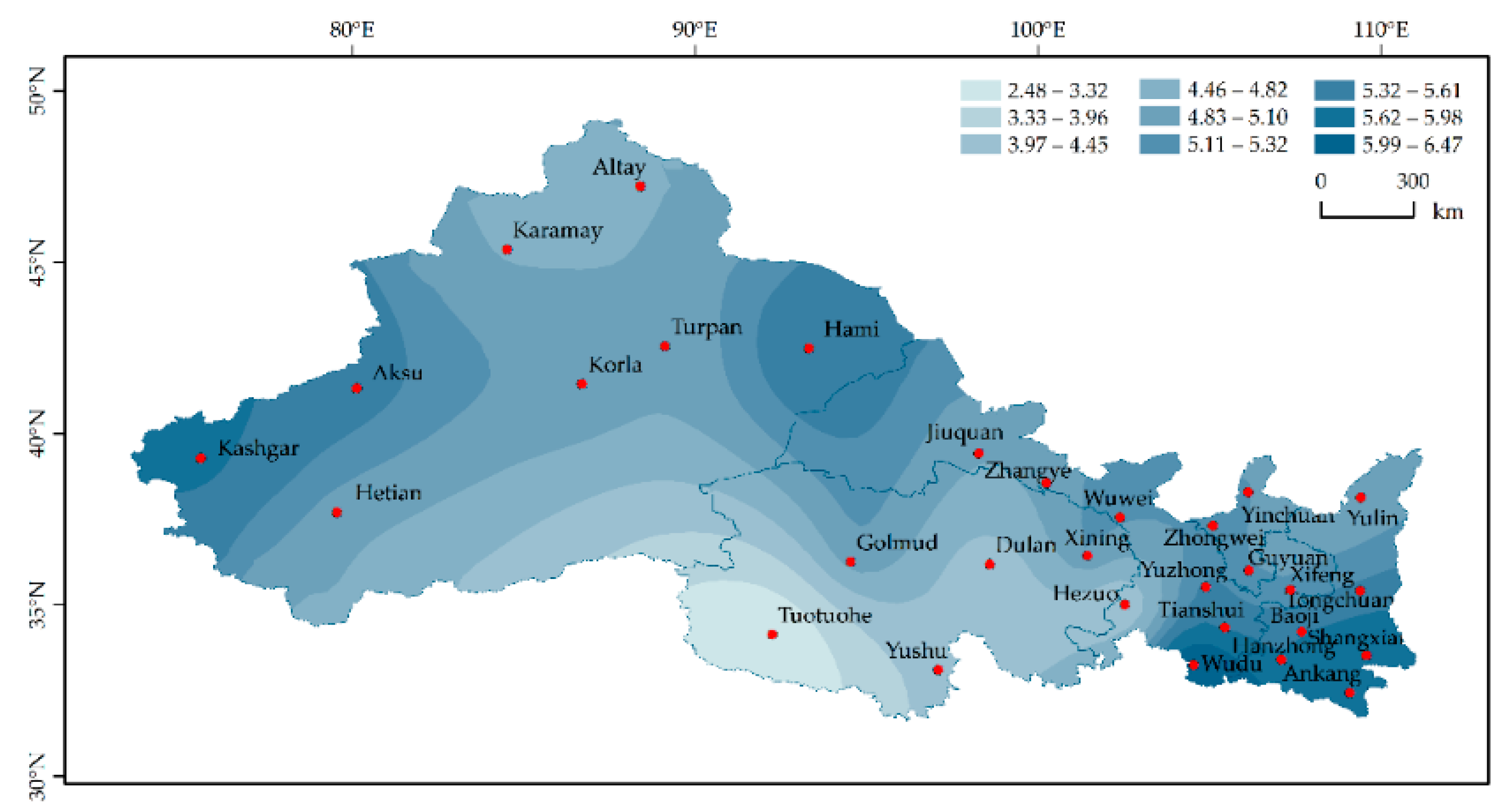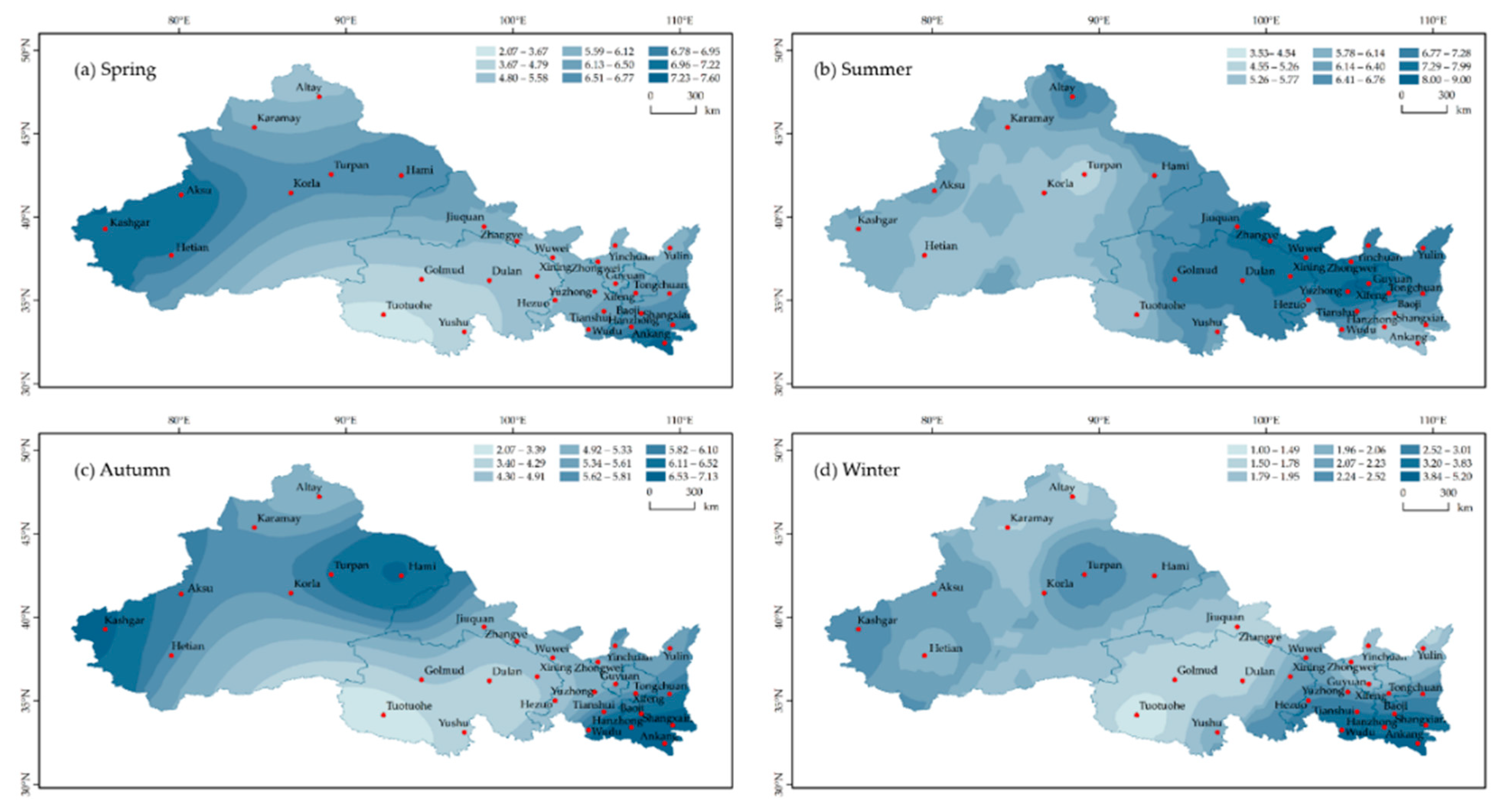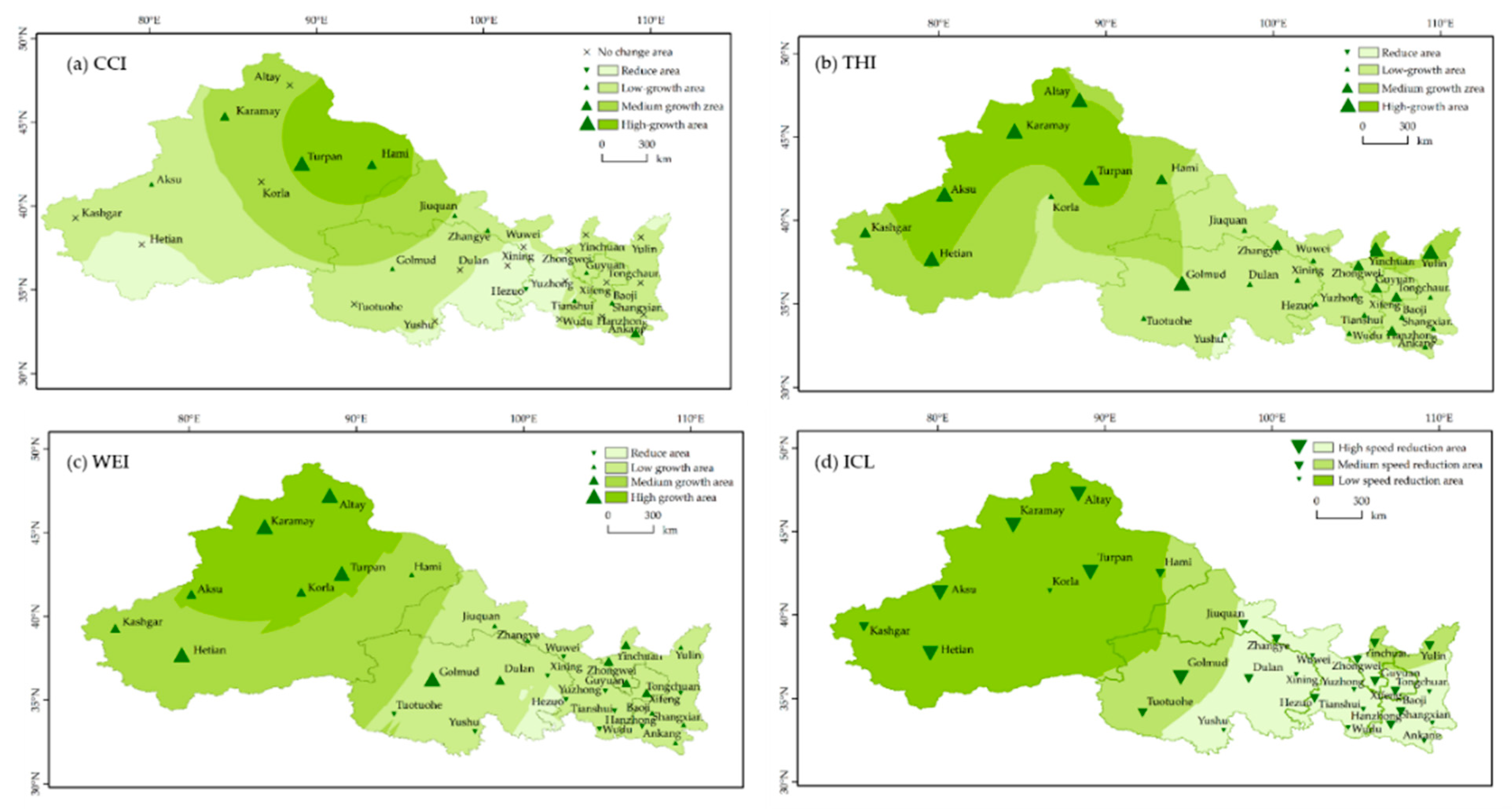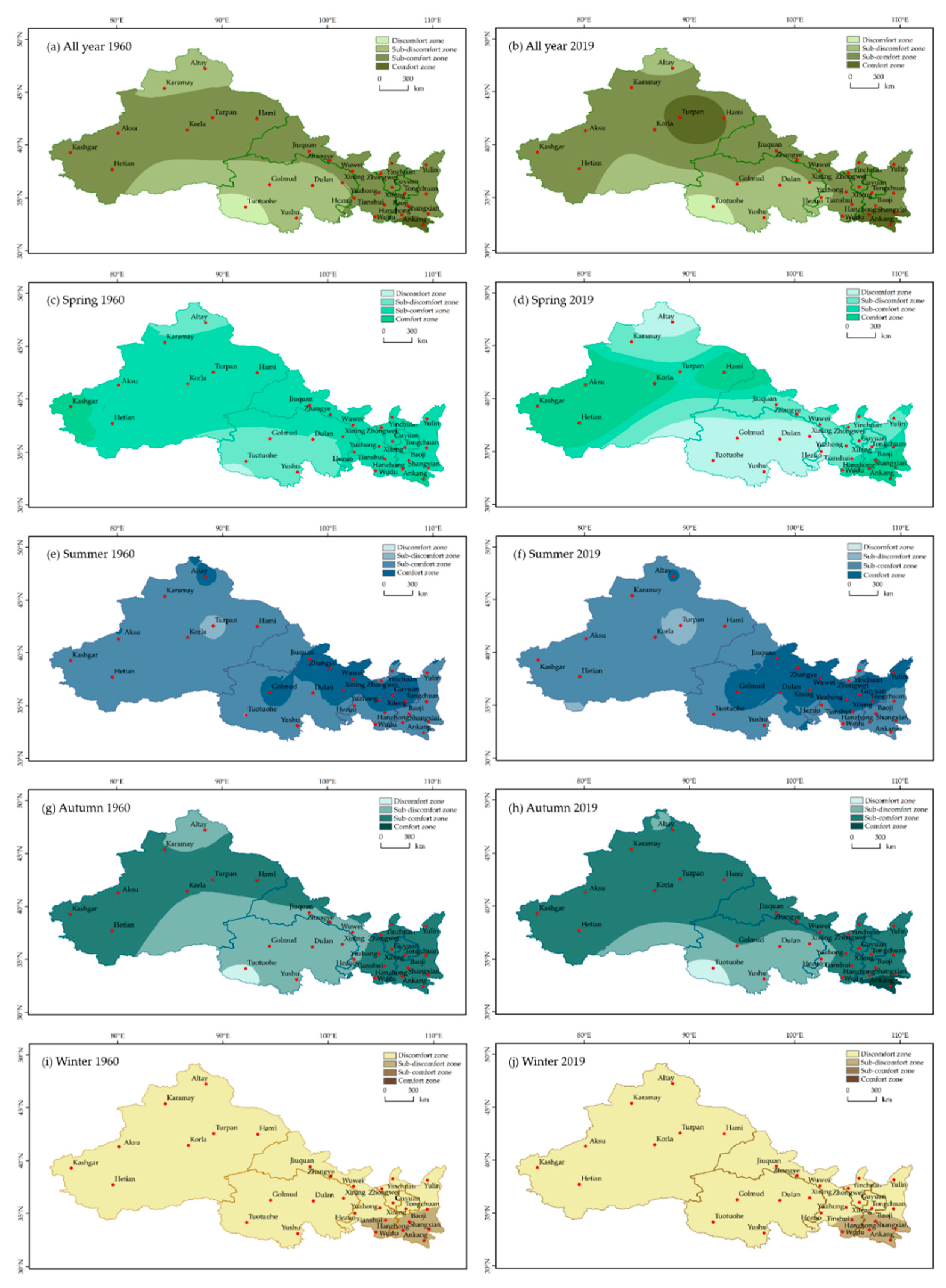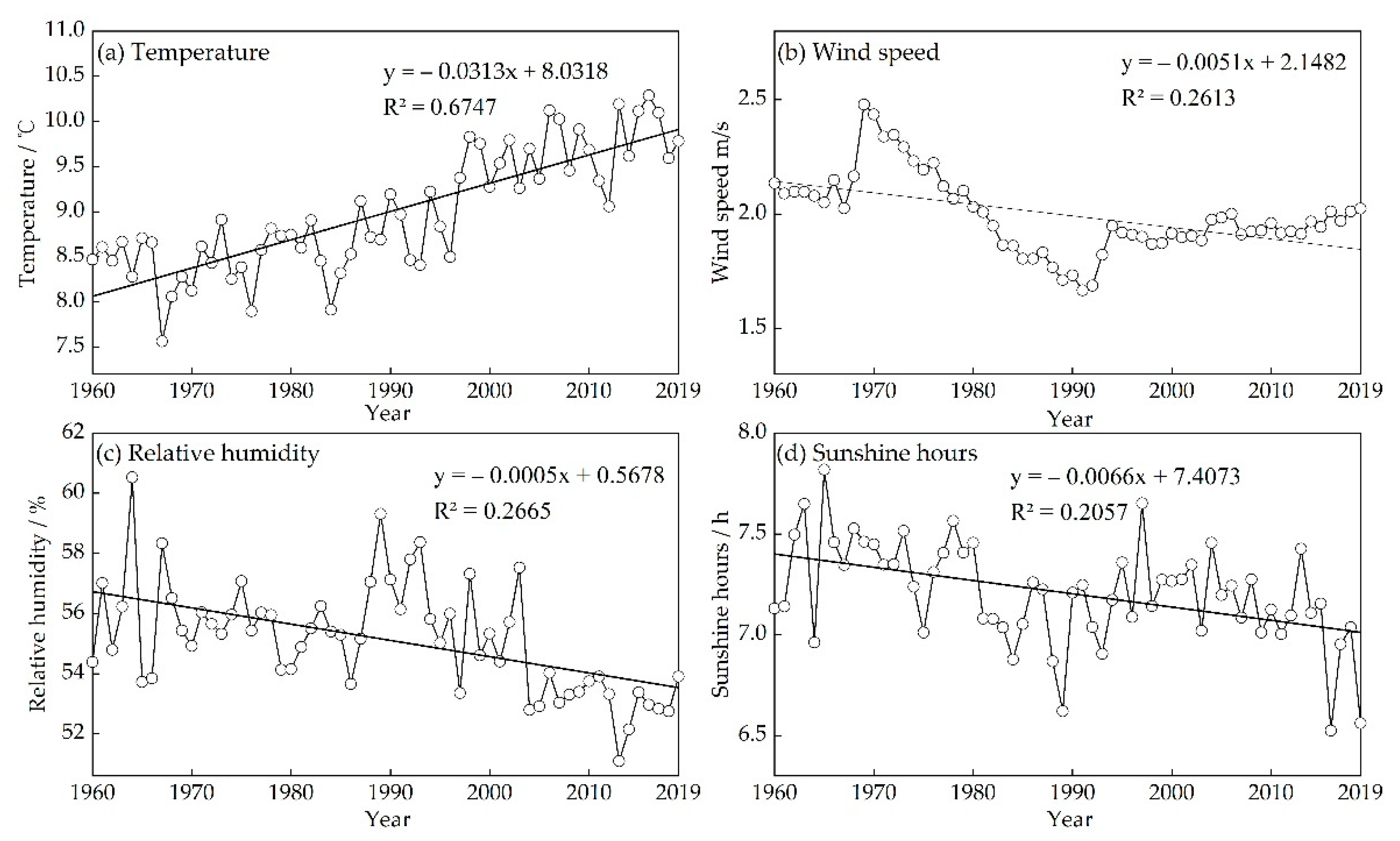1. Introduction
Climatic comfort refers to the climatic conditions under which people can ensure the normal progress of physiological processes without resorting to any cold and heat-relief measures [
1]. It is used to evaluate the comfort state of the human body under different climatic conditions from the perspective of meteorology. A bio-meteorological index is based on the heat exchange between the atmospheric environment, which reflects the human body’s awareness of the degree of satisfaction with the thermal environment [
2]. At the same time, it is also an important factor to measure the impact of climate change on tourism activities and human settlements [
3]. The difference in climatic comfort in different regions directly leads to the length and seasonal distribution of the regional climatic comfort period, which is of decisive significance for the attractiveness of regional tourist destinations and the development of regional tourism.
Foreign scholars started early in the study of climate comfort. In the 1920s, Houghthon and Yaglou [
4] determined the iso-comfort line of naked men with two variables including temperature and humidity and proposed an effective temperature index with far-reaching influence. Burton et al. systematically described the effect of temperature and humidity on comfort [
5]. Subsequently, Thom [
6] and Terjung [
7] successively proposed discomfort index, comfort index, and wind efficiency index, which enriched the theoretical research on climate comfort. Since then, research related to climate comfort has begun to develop and gradually build various climate comfort indexes and evaluation models such as temperature and humidity index, wind efficiency index, clothing index, etc. Oliver [
8] proposed and established a temperature–humidity index and a wind–cold index scale, created applied climatology, and research related to climate comfort gradually became mature. Research on the relationship between climate change and tourism is also comprehensive, focusing on the impact of climate on tourism demand [
9], the impact of temperature on tourist demand [
10], and climate influences on tourism destinations [
11] and other aspects.
Domestic research on tourism climate started relatively late, but the development progress is relatively fast. Most of the early studies on tourism climate in China focused on the evaluation of tourism climate resources [
12,
13,
14,
15], and later studies combined comprehensive analysis of tourism development [
16,
17]. After more in-depth research, it is found that it is more scientific and convenient to use various meteorological factors to evaluate tourism climate. Therefore, after Zhang Jianguang and Feng Yunfei introduced the concept of “agreeableness” [
18], research on tourism climate comfort has developed rapidly in China [
19,
20,
21,
22]. After entering the 21st century, research on climate comfort is no longer limited to a single scenic spot or city, but a comprehensive evaluation from a large spatial scale [
23,
24,
25,
26,
27]. With the introduction of geographic information technology and fuzzy evaluation methods, climate comfort evaluation has gradually developed in the direction of accuracy [
28,
29,
30,
31]. In addition, some scholars have researched the impact of climate comfort changes on tourist flow [
22,
32,
33], all of which have achieved a series of results.
The Intergovernmental Panel on Climate Change (IPCC) Fifth Assessment Report pointed out that the global temperature has increased substantially since 1951 [
34], and under the simulated scenarios of different emission concentrations, the future temperature will continue to rise [
35]. Global warming has become an indisputable fact and has formed a differential regional climate response [
36], which objectively causes climate comfort and comfort period to have different characteristics in different regions, and to a certain extent, it affects the quantity and quality of tourism resources, leading to changes in the flow and direction of tourism activities [
37]. Northwest China has a vast territory, a large east–west span, and complex and diverse underlying surface conditions. Therefore, regional differences in climate change are particularly prominent, and the degree of impact on different regions is not the same [
38,
39]. Research on climate comfort in the Northwest has only gradually started in the past 10 years [
40,
41,
42,
43]. As an important part of the Silk Road, the northwestern region is rich in natural landforms, diverse ethnic customs, and cultures, and tourism resources are cross-cutting and similar, but each has its characteristics. Therefore, the development of tourism has obvious advantages. With the further warming of the global climate, the study of tourism climate comfort should receive more and more attention and become one of the important contents of human settlement environment climate assessment and tourism climate resource evaluation.
However, the current research on climate comfort in the Northwest is mostly for a single city or a single province, and there are few studies on the comfort of the entire Northwest (including Shaanxi, Gansu, Ningxia, Qinghai, and Xinjiang). Furthermore, there is a relative lack of long-time scale (60 years) studies on, and regular analysis of, changing climate comfort characteristics. Especially since the 1950s, against the background of global warming and the accelerating trend of warming, the climate comfort period in Northwest China is bound to change to varying degrees, which will have an important impact on the human settlement environment and tourism resources in the future. Based on this, this article builds a comprehensive climate comfort index based on 60 years of climate statistics, using temperature and humidity index (THI), wind efficiency index, (WEI), and clothing index (CCI). This paper systematically analyzes the spatiotemporal evolution of the 60-year tourism climate comfort of 30 representative cities in Northwest China against the background of climate warming. The paper calculates the statistical comfort period distribution through hierarchical assignment and weighting, and uses kriging spatial interpolation and spatial clustering to deeply study the change types and trends of the climate comfort index. It further analyzes the characteristics of the spatial range changes of different comfort levels against the background of climate change, in order to explore the best travel time in each region. This reveals the differences in the temporal and spatial distribution of climate comfort in different regions in the study area, so as to provide a theoretical basis for the rational development of tourism climate resources.
4. Discussion
With the acceleration of urbanization and global warming, the climatic comfort of the human living environment has undergone major changes, and there are differences in regional temporal and spatial characteristics [
49,
50,
51]. The climate comfort of a specific area is an important indicator of climate change that affects the human living environment. It is a comprehensive manifestation of coordinating the construction of regional ecological civilization, coping with climate change and disaster prevention and mitigation, and is the basic guarantee for realizing regional green and sustainable development. Based on THI, WEI, ICL, and CCI, this paper establishes a comprehensive climate comfort evaluation model and uses this model to complete the analysis of climate comfort in 30 representative cities in Northwest China. The results show that the annual average climate comfort in Northwest China ranges from south to the northwest in an upward trend that is gradually significant. Among them, the summer climate comfort value is the largest, and the range of the comfort zone increases significantly in spring and summer. May and September have the most cities suitable for tourism. This is consistent with the results of previous studies [
51,
52].
In recent years, different regions in the Northwest have also been conducting evaluations on urban climate comfort, which not only helps to promote the construction of ecological civilization, but also an important breakthrough for the development of a green economy and circular economy. From 1960 to 2019, with the increase in average temperature in the northwest region, the decrease in average wind speed, relative humidity, and sunshine hours (
Figure 7) all have certain effects on THI, WEI, and ICL.
Table 7 shows the correlation coefficients between various meteorological elements and the comfort evaluation index. It is found that the trend of warming temperature and decreasing wind speed in the northwest region increases the climate comfort index (correlation coefficient is 0.88,
p < 0.01) and extends the local comfortable period of travel. The decrease in sunshine duration may affect the increase of wind speed (correlation coefficient of 0.47,
p < 0.01) and the increase of clothing index (correlation coefficient of 0.48,
p < 0.01). The decrease in relative humidity may reduce the number of sunshine hours (correlation coefficient is −0.81,
p < 0.01). These all affect the increase in climate comfort and are not conducive to the development of tourism activities. According to the research in this article, the climate comfort level in the study area has changed significantly. The comfort level of cities close to the north increases faster than that of the southern city, indicating that the annual comprehensive comfort index of cities with higher latitudes is on the rise, which is conducive to the development of urban tourism. The annual comprehensive comfort index of cities with lower latitudes is on a downward trend, and the climate comfort period is shortened, which inhibits the development of urban tourism. In different altitude areas, as the altitude increases, the climate comfort index is the most affected by temperature. The influence of sunshine hours gradually increases but the change is not obvious. The influence of wind speed first decreases and then increases. The degree of influence of humidity gradually decreases. In summary, the climate comfort index in Northwest China may be the result of the combined effect of latitude, altitude, and related human factors. It can be seen that the climate comfort index is used to comprehensively evaluate and analyze the differences in climate change between regions and the sensitivity of the human body to climate. On the one hand, it can scientifically guide people to travel and appropriately change their behaviors in accordance with climate change, and provide a reference for the sustainable development of Northwest China and the improvement of human settlements. On the other hand, it can guide the production and life of human society, and conduct meteorological services and tourism planning by studying the trend and distribution of climate comfort.
The impact of global climate change on the tourism industry in Northwest China is a “double-edged sword”. Although global climate change in recent years has brought certain challenges to human life, for mid-to-high altitude areas, the main cause of uncomfortable weather is the influence of cold air in winter, and the increase in temperature mitigates the influence of cold air in winter, making the climate comfort develop from uncomfortable to a comfortable range. In addition, climate change has also had a positive impact on off-season tourism in Northwest China [
53], which can prolong the tourism season in the area and reduce the adverse effects of climate fluctuations. Therefore, the development of tourism not only helps to mitigate climate change but also continuously adapts to climate change. At the same time, for the sensitive and vulnerable areas of climate change, adaptive and alternative tourism products should be developed, including reasonably planning for the protection of glacier landscapes and strengthening the development and protection of sensitive resources such as wetlands and lakes. Fully protecting ecological tourism resources will improve the utilization rate of tourism resources, and accelerate the sustainable development of tourism resources [
54,
55].
The comprehensive comfort evaluation index constructed in this paper based on three climate indexes can reflect the degree of regional climate comfort to a certain extent, but its construction method and classification standards still need to be further studied in detail. Since the evaluation of comfort was related to meteorological factors, as well as the characteristics of the underlying surface, eyeballs, air quality, etc., further research is necessary. In addition, the terrain conditions in Northwest China are complex, with plateaus, mountains, basins, and other types of landforms, and different landforms have different climatic conditions. In the future, after the regional automatic weather station data passes strict quality control, we can try to make full use of the regional automatic weather station data to carry out more refined climate comfort analysis and research in Northwest China.
